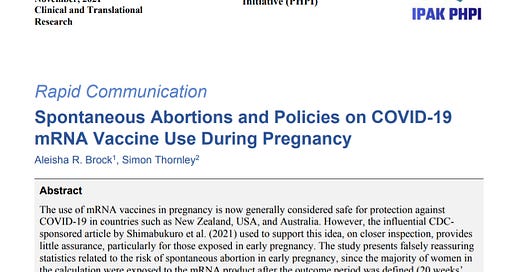Report Finds Increased Risk of Spontaneous Abortion Following COVID-19 Vaccination During Pregnancy
Epidemiologists Find CDC Study Contains Major Error
PRESS RELEASE
11/1/2021
Auckland, NZ
In a new peer-reviewed Rapid Communication published in Science, Public Health Policy & the Law, scientists affiliated with the University of Auckland Epidemiology and Biostatistics division in the School of Population Health report that the US CDC made a grave error in its own report on whether COVID-19 vaccination leads to spontaneous abortions when used during pregnancy.
Drs. Simon Thornley and Aleisha Brock report:
“…the influential CDC-sponsored article by Shimabukuro et al. (2021) used to support this idea, on closer inspection, provides little assurance, particularly for those exposed in early pregnancy. The study presents falsely reassuring statistics related to the risk of spontaneous abortion in early pregnancy, since the majority of women in the calculation were exposed to the mRNA product after the outcome period was defined (20 weeks’ gestation).”
The authors then performed their own re-assessment and estimated that unexpected termination of pregnancies actually occurred at a rate 7-8 times higher in vaccinated pregnant women than the rate in the baseline over the same time period.
The report, which was peer-reviewed using a blinded review process in which the authors were unaware of the reviewers’ identities, is one of a growing number of reports and studies by academic researchers who find the studies and reports from official sources flawed, fraudulent, or rife with unacceptable errors.
The article includes a note from SciPub Editor-in-Chief Dr. James Lyons-Weiler which reminds the reader that Dr. Shimabukuro, who authors the flawed report, also failed to detect any signal of myocarditis in his analysis of data from another system (the Vaccine Safety Database) in a report to the HHS Advisory Committee on Immunization Practices as well as in his report to the Vaccines and Related Biological Products Advisory Committee (VRBPAC). Myocarditis is a medical condition that is now known by the FDA as a risk that must be communicated to people receiving COVID-19 vaccinations.
Science, Public Health Policy & the Law is an official publication of the The Institute for Pure and Applied Knowledge, Public Health Policy Initiative (IPAK PHPI) that publishes peer-reviewed studies, reports and analyses of the mismatch between science, public health, medical practice and the law.
The same journal published a review critical of CDC’s COVID-19 reporting practices, which are now known to be biased upward due to a number of important factors, including an unacceptably high false positive rate in the use of PCR tests to diagnose COVID-19 and to determine cause of death in persons who may or may not have a SARS-CoV-2 infection. It also recently published an analysis of the CDC’s vaccine adverse events reporting system (VAERS) which found that more deaths had been reported in the months following the start of the COVID-19 vaccination program than in all of the years that VAERS has been collecting data, for all vaccines combined.
Citation: Brock, AR, S Thornley. 2021. Spontaneous Abortions and Policies on COVID-19 mRNA Vaccine Use During Pregnancy (Rapid Communication, Clinical and Translational Research) Science, Public Health Policy & the Law 4:130-143.
Dr. Simon Thornley is available for interviews and appearances at the email address listed in the publication.






Brilliant work here! 🙌
Tom Shimabukuro is a criminal. He absolutely must be tried at Nuremberg 2.0. His entire job is using statistical gimmicks to try to make obvious vaccine safety signals go away. He's one of the worst human beings on the planet.
The paper from June presented the first one or two snapshots from the pregnancy registry, which goes weeks between participant updates. Both the original and Thornley / Brock's use of "completed pregnancies" as the denominator leaves out the still ongoing pregnancies, so it's weird to see the original mistake repeated in the latter case (just "-minus +20 weeks completed," but still leaving out ongoing).
Minus Shimabukuro, the latest update on September 9 captures most of the <20 week participants at a post-20 week snapshot - https://pubmed.ncbi.nlm.nih.gov/34496196/ . They use some weird math but the raw numbers seem non-alarming. Conspicuously, they have stopped showing numbers for ended pregnancies after the 20 week mark - are they hiding an unexpected signal for post-20-week events?
Also worrying is that complications arising after delivery wouldn't show up in the study (if they restored reporting on all outcomes) among the completed births cohort - there are rumors of deaths in the day after birth...